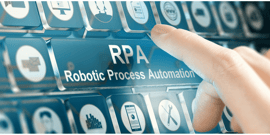BP3 GLOBAL-SERVICE
Finding R.O.I in Automation: What You Should Measure
Watch now to learn where it is that you should start to measure to find your R.O.I in automation, and where you definitely don't want to start.
Krista: Thanks, Larry, for joining us today. So today, we are talking about finding R.O.I. in automation and where you start to measure. So, let's go with that. Where do you start to measure to find your R.O.I. in automation?
Larry: Yeah, so let me suggest there's a place where we don't want to start, and that is by trying to imagine that an automation project is intended to allow us to cut headcount or something like that. I think that's always a bad proposition. That's not how you value automation and digital capabilities.
Larry: The real, true value that you'd see behind automation or digital technologies is always going to be directly in line with the business outcome measures that the business already uses. So, as an example, if it's speed through a clinical trial, then we should measure the impact, the return on investment for automation or digital in terms of speed for delivery of a clinical trial, not in terms of-of how many labor hours we might have saved or how fast a particular process works, but how fast we move the clinical trial process forward.
Larry: So, that's first and foremost, so you really need to be able to check that box and say, "Yup, we're using a business measure for determination of R.O.I." The second thing I think is really important is making sure that the C suite or the senior executives, they've signed off on a strategy, written or spoken, preferably written that says, "Hey, here's where we're trying to go with digital in the next five years and here was the value proposition behind it." It's not always easy to put a dollar value behind something that you're trying to do and trying to advance technology. And so, for that reason, it's important that all the minds and the best thinking that you have running your strategy aligns to what the business objectives are for say, the next five years.
Larry: And the third point, that I think is really important to emphasize is that when you think about automation and digital, think about how you can build the solution in a way that actually produces the return on investment measurement as part of how the process runs. So imagine that you build a process for standing up a clinical trial location, okay. And standing it up quicker, and faster through digital technologies. Well, that solution ought to provide the measure on an ongoing basis on how fast are you standing up the trials. And so that should be part of the solution design. So that would be another box to check. To make sure you're really driving return on investment.
Krista: So, really, starting with where you want to measure versus starting with where you want to get someday.
Larry: Yes.
Krista: Starting with where you want to measure and making sure that that's built into the solution.
Larry: Yes. Make sure you're moving towards the business goals, not trying to solve an individual problem and not trying to just remove headcount or something like that, but always keep your eyes on the future business goal. Make sure that your solutions are geared toward demonstrating that capability.
Krista: Well, that's great. I love the way you think and the way we can start measuring our automation R.O.I. So, thank you for joining us and we look forward to hearing from you again soon.
Larry: Sure.


